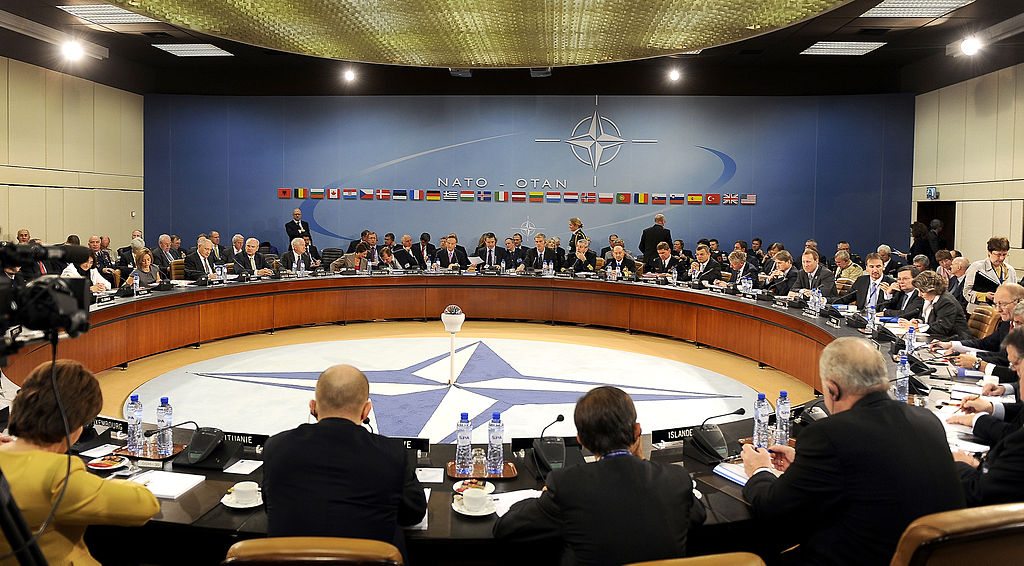American policymakers have shown a surprising about of sanity so far in response to Russia’s invasion of Ukraine. While some war enthusiasts among the American punditry have certainly been agitating for World War III, the leadership in both the White House and Congress have repeatedly and straightforwardly refused most calls to escalate the conflict.
Unfortunately, a number of foreign parliaments among the U.S.’ NATO “partners” have not been nearly as hesitant to escalate matters. Among the most reckless on this issue have been lawmakers from a number of eastern European states. For example, policymakers in the Baltics in recent weeks have called for a no-fly zone in Ukraine. Newsweek reported this month:
Lithuania’s parliament unanimously approved a resolution calling for a no-fly zone over Ukraine—joining other NATO members Estonia and Slovenia in the appeal. Rihards Kols, chairman of the Latvian parliament’s foreign affairs committee, also announced [March 17] his country is calling for such a zone.
But here’s the problem: a so-called no-fly zone would be an de facto declaration of war on Russia by NATO. Moreover, when we say “by NATO” we really mean mostly “by the United States.”
At around the same time, the Polish regime began its own scheme to escalate the war and bring the U.S. into direct conflict with Moscow. Warsaw, apparently without consulting Washington, hatched a plan to send fighter jets to Ukraine via U.S. military bases, and then have the U.S. “backfill” Poland’s air force with F-16s. This would have constituted a significant escalation as well, and was fortunately quashed by the White House.
This sort of behavior that free-rides on the American taxpayer has become an identifiable pattern from countries that see themselves as benefiting enormously from U.S. military spending—but who contribute next to nothing to U.S. security or even to the NATO alliance.
As a result, when Estonian lawmakers—Estonia being a country that has no air force at all beyond a few unarmed surveillance aircraft—want a no-fly zone, these people know it will be mostly somebody else who will fight, die, and sacrifice to pay for it all. “Someone else,” of course, will often mean American pilots and American taxpayers.
Moreover, the idea that these countries offer any sort of strategic advantage to the U.S. in terms of defending vital American interests is implausible. The current war in Ukraine has well illustrated just how weak the Russian regime is in terms of projecting power anywhere beyond its immediate neighbors. The idea that Poland and Estonia serve as valuable “buffer states” between the U.S. and a second-rate power like Russia is hardly convincing. These NATO members are simply not critical allies. Rather, they are net liabilities that may even end up forcing an escalation that draws the US into a war with another nuclear armed power. The U.S.’ pledge to defend eastern Europe through organizations like NATO can at best be described as a form of humanitarian aid for member states that have nothing to offer in terms of vital American geopolitical benefits.
Who Pays for NATO?
Through collective security organization like NATO, Americans find themselves in a position of financially supporting the military defense institutions of foreign states that not only benefit from the largesse, but have the potential of turning regional wars into a global Third World War.
The unfortunate mechanism behind all this is NATO’s key provision—Article 5—which states that an attack on any member shall be considered to be an attack on all members. This means that when some NATO members court conflict and act recklessly, this could end up imposing large costs on all other NATO members.
This enormous downside to NATO’s structure is generally ignored in favor of focusing on NATO’s presumed deterrent effect. That is, it is assumed that the enormous amount of military resources controlled by all NATO members overall will prevent any outside state from attacking any NATO member.
Some member states, however, contribute an outsized amount of this spending while other states contribute very little. This is true in the two types of spending on which NATO and its deterrent effects are based.
The first is NATO’s operational budget which collectively funds NATO joint programs and institutions. In this, the US has historically funded more than a fifth of all funding. As recently as 2019, for instance, 22.1 percent of NATO’s “common-funded budgets” came from the United States. Germany, came in second place with 14.7 percent, and France came in third with 10.5 percent. In 2021, NATO members adopted new budgeting which reduced the U.S.’ share. The current plan, to last through 2024, will have the U.S. as the largest contributor, but at 16.3 percent of common funding, matched at the same amount by Germany. The United Kingdom and France are third and fourth, respectively, with 11.3 percent and 10.5 percent of common funding.
Total spending on the NATO budget, however, is a small affair at only 2.5 billion euros.
Military Spending by Member States
The real benefit of NATO membership—felt mostly by its small-state members—comes from the deterrent effect that comes from the collective military capability of all members.
For example, total military spending of all NATO members combined is more than one trillion dollars. So how much of this total is provided by U.S. taxpayers? In the first graph, we see that the US’s share of this is 70.5 percent, and that the top ten countries here constitute 95 percent of all military spending. That is, the U.S. spends 70 percent of all NATO defense dollars while the next nine states contribute an additional 25 percent. The other twenty NATO member states contribute a meagre and forgettable five percent of all spending:
Source: Stockholm International Peace Research Institute (2020 figures in constant 2019 US dollars).
In the second graph, we see this spending expressed in constant 2019 dollars. (I’ve left off the U.S. for the sake of providing a better sense of scale.) Most NATO members spend totals on defense that constitute a tiny fraction of U.S. spending—which totaled 766 billion in these 2020 numbers. The next largest spender—the UK—comes in at less than one-tenth of US spending at 58.4 billion. Estonia, meanwhile—where a majority of legislators call for the rest of NATO to enforce a no-fly zone—spends less than one billion.
Source: Stockholm International Peace Research Institute (2020 figures in constant 2019 US dollars).
Admittedly, of course, it is not reasonable to expect a NATO member like Latvia or even Hungary to spend hundreds of billions of dollars on military personnel and equipment. They’re simply too small. But even when military spending is measured as a percentage of GDP, it is clear these countries are counting on someone else paying most of the tab.
By this measure, the U.S. still spends the most at 3.7 percent of GDP. Yet, no other NATO member even cracks three percent, and, at least as of 2020, eighteen members were spending less than two percent of GDP on defense.
Source: Stockholm International Peace Research Institute (2020 figures in constant 2019 US dollars).
By pointing this out, I’m not congratulating the United States regime for spending enormous amounts of taxpayer wealth on the Pentagon. Indeed, military spending in the U.S. is absurdly bloated. Much of this spending is claimed to be necessary on the grounds that the United States must “defend” Europe—and thus continue to allow Europe’s regimes to milk American taxpayers, year in and year out. Nor am I claiming the U.S.’ regime is a victim here. The regime in Washington clearly benefits from this status quo since it ensures Washington retains an enormous amount of geopolitical power and well-funded military institutions. Rather, it is the U.S. taxpayer who suffers in this corrupt bargain between Washington elites and the regimes of Europe.
So, if the regimes of Europe are ever going to stop being the world’s welfare queens—sponging off the hard work of America’s productive population—the U.S. regime is going to have to be starved of defense dollars until the regimes of Europe are forced to go justify the cost of military defense to their own taxpayers. As I’ve pointed out here, the medium-sized states of Europe have more than enough wealth and military potential to deal with a second-rate power like Russia. The American taxpayers, on the other hand, deserve a break from Europe’s grifting.
This article was originally featured at the Ludwig von Mises Institute and is republished with permission.


































